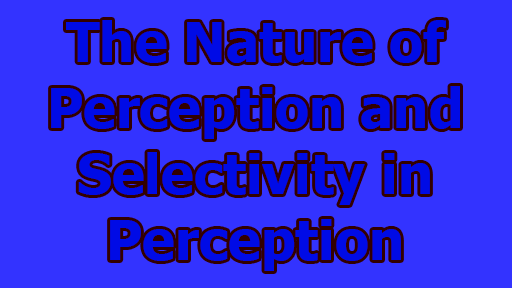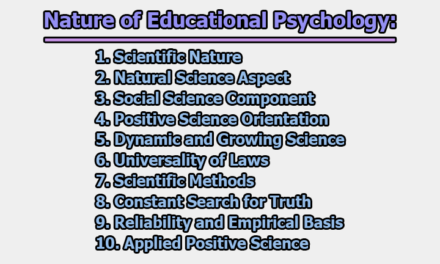The Nature of Perception and Selectivity in Perception:
Perception is a fundamental cognitive process that allows individuals to interpret and make sense of the world around them. It is through perception that humans and other organisms gather information from their environment and construct a mental representation of reality. This mental representation serves as the foundation for decision-making, understanding, and interaction with the external world. However, perception is not a passive recording of sensory inputs; rather, it involves a complex interplay of sensory mechanisms, cognitive processes, and selectivity. In the rest of this article, we will explore the nature of perception and selectivity in perception.
Understanding Perception:
Perception can be understood as the process by which sensory information from the environment is transformed into meaningful experiences. This process encompasses various senses, including vision, hearing, touch, taste, and smell, each of which contributes to an individual’s overall perception of the environment. These sensory inputs are relayed to the brain, where they are processed, integrated, and interpreted to form a coherent perception of reality.
The Multistage Process of Perception:
Perception is not a simple one-to-one translation of sensory input into conscious experience. Instead, it involves multiple stages of processing, each contributing to the construction of the final perceptual experience. Let’s discuss the multistage process of perception.
1. Sensation: Sensation is the initial stage of perception where sensory receptors detect and encode raw sensory information from the environment. This information is in the form of physical stimuli, such as light waves for vision, sound waves for hearing, and pressure for touch. Sensory receptors are specialized cells located in the sensory organs, like the retina in the eye or the cochlea in the ear.
For instance, in vision, the photoreceptor cells in the retina detect photons of light and convert them into electrical signals. These signals are then transmitted to the brain through the optic nerve. In hearing, the vibrations of sound waves are captured by hair cells in the cochlea, which send electrical signals to the brain via the auditory nerve.
2. Attention: Attention is a critical aspect of perception that involves selecting and focusing on specific sensory inputs while filtering out others. The vast amount of sensory information bombarding us at any given moment requires a mechanism to prioritize relevant stimuli for further processing. Attentional mechanisms help us direct our cognitive resources to the most salient or meaningful stimuli.
There are two main types of attention: bottom-up and top-down. Bottom-up attention is driven by the inherent characteristics of stimuli, such as their intensity, novelty, or contrast. For example, a sudden loud noise in a quiet room will automatically capture our attention. Top-down attention, on the other hand, is guided by our goals, expectations, and cognitive priorities. If we are searching for a specific object in a cluttered scene, our attention will be directed to objects that match our mental representation of the target.
3. Organization: Once attention has filtered relevant sensory information, the brain organizes these inputs into meaningful patterns. This organization is guided by a set of principles known as Gestalt principles. These principles describe how the brain groups individual sensory elements to form a coherent and recognizable whole.
The Gestalt principles include:
- Proximity: Elements that are close to each other are perceived as belonging together.
- Similarity: Similar elements are grouped together based on their common features.
- Closure: Incomplete or fragmented stimuli are perceived as complete shapes.
- Continuity: Elements that follow a smooth and continuous path are grouped together.
- Figure-Ground: Perception naturally segregates the visual field into a foreground (figure) and a background (ground).
These principles contribute to the perception of familiar objects, scenes, and patterns.
4. Interpretation: Interpretation is the stage where the brain assigns meaning to the organized sensory patterns. It involves using prior knowledge, experience, and contextual cues to make sense of the perceived information. The brain relies on top-down processing, where higher-level cognitive processes influence the interpretation of sensory inputs.
For example, if you see a partially hidden object, your brain might use your knowledge of common objects to fill in the missing information and perceive the complete object. Similarly, the interpretation of an ambiguous image can be influenced by the context in which it is presented.
5. Recognition: Recognition is the final stage of perception, where the brain matches the interpreted sensory information to existing memory representations. This process allows us to identify and categorize objects, people, places, and situations in our environment. Recognition is influenced by our memory, previous experiences, and the associations we have formed over time.
For instance, when you see a familiar face, your brain rapidly matches the visual input to stored memories of that person’s face, enabling you to recognize them. Similarly, the recognition of written words relies on matching the visual patterns of letters to stored linguistic knowledge.
6. Multisensory Integration: While the process described above focuses on individual sensory modalities, perception often involves the integration of information from multiple senses. Multisensory integration enhances our perception by providing complementary and overlapping information from different sensory channels.
For instance, when we perceive an object, such as a ringing phone, our brain combines visual cues (the sight of the phone ringing), auditory cues (the sound of the ringing), and possibly tactile cues (feeling the phone’s vibration) to form a complete and accurate perception of the event.
Selectivity in Perception:
Selectivity in perception refers to the cognitive process through which the brain filters and prioritizes sensory information from the environment, allowing us to focus on relevant stimuli while disregarding irrelevant or overwhelming inputs. This intricate mechanism is essential for managing the constant influx of sensory data and constructing a coherent representation of reality. Selectivity in perception is influenced by a combination of bottom-up sensory processes and top-down cognitive influences, shaping our conscious awareness of the world around us.
I. Sensory Thresholds and Detection: Sensory systems have specific thresholds that dictate the minimum intensity or difference required for a stimulus to be detected. These thresholds vary between individuals and sensory modalities. For instance, the absolute threshold for vision refers to the smallest amount of light needed for a person to detect a visual stimulus. Similarly, the just noticeable difference (JND) in hearing represents the smallest change in sound intensity that can be detected.
These thresholds play a crucial role in selectivity, as stimuli below these thresholds might not reach conscious awareness. Therefore, not all sensory inputs are processed equally, and only those surpassing these thresholds are further attended to and processed.
II. Attentional Selectivity: Attention is a central mechanism in selectivity. It involves focusing cognitive resources on specific sensory inputs while ignoring others. Attentional selectivity is driven by both bottom-up and top-down processes.
- Bottom-Up Attention: Stimuli that stand out due to their intensity, novelty, or contrast capture attention automatically. For example, a sudden loud noise in a quiet room grabs our attention, illustrating bottom-up attentional capture.
- Top-Down Attention: This type of attention is influenced by an individual’s goals, expectations, and cognitive priorities. When you search for your friend in a crowd, your top-down attention focuses on faces while disregarding other irrelevant stimuli.
III. Inattentional Blindness and Change Blindness: Inattentional blindness occurs when individuals fail to notice fully visible, unexpected stimuli because their attention is engaged elsewhere. This phenomenon highlights the limited capacity of attention and the fact that we can only process a fraction of the available sensory information. Change blindness is a related phenomenon where individuals do not notice significant changes in a scene when they are not attending to the specific aspect that changed.
IV. Selective Filtering Mechanisms: The brain employs selective filtering mechanisms to manage the overwhelming amount of sensory input. These mechanisms include sensory adaptation, where sensory receptors become less responsive to constant stimuli over time. This adaptation allows us to focus on changes in the environment rather than continuous, unchanging stimuli. For example, after entering a room with a strong odor, you might stop noticing the smell after a while.
V. Cognitive Biases and Expectations: Cognitive biases are systematic patterns of deviation from rationality or norm. They can influence how we perceive and interpret information. One example is confirmation bias, where individuals tend to selectively attend to and interpret information that confirms their existing beliefs, while disregarding contradictory evidence.
Expectations and beliefs also play a role in selectivity. Our prior knowledge and assumptions can lead us to perceive stimuli in ways that align with these expectations. This can lead to biased interpretations of ambiguous stimuli based on our preconceived notions.
VI. Emotional Influence: Emotions play a significant role in shaping selectivity. Emotional stimuli, particularly those with a threatening or rewarding nature, tend to capture attention more readily. This is a survival mechanism that directs our attention toward stimuli that might be relevant to our safety or well-being. For instance, if you’re walking in a forest and hear a rustling sound, your attention will quickly focus on the source of the noise due to the potential threat it represents.
VII. Multisensory Integration and Cross-Modal Attention: Perception often involves integrating information from multiple sensory modalities. The brain combines inputs from vision, hearing, touch, taste, and smell to create a more comprehensive and accurate perception of the environment. This cross-modal integration can influence which sensory inputs are prioritized and how they are combined to form a holistic perception.
VIII. Factors Influencing Selectivity: Several factors influence selectivity in perception:
- Individual Differences: Different individuals exhibit varying levels of selectivity based on personality traits, cognitive styles, and past experiences.
- Cultural and Social Factors: Cultural norms and social contexts shape what individuals perceive and how they interpret sensory inputs. This leads to differences in perception across cultures.
- Expectations and Beliefs: Our expectations and beliefs guide our attention and interpretation, affecting which stimuli we notice and how we perceive them.
- Attention Disorders: Conditions like ADHD can disrupt typical mechanisms of attentional selectivity, leading to difficulties in filtering and processing sensory information.
IX. Practical Implications: Understanding selectivity in perception has practical implications across various domains:
- Design and Marketing: By understanding how attention is captured and maintained, designers and marketers can create more engaging and effective visual and auditory content.
- Education: Teachers can optimize instructional materials and strategies to align with attentional mechanisms, enhancing student engagement and learning.
- Media Consumption: Recognizing how cognitive biases affect perception can empower individuals to critically evaluate information sources and avoid falling into confirmation bias traps.
- Safety and Human Factors: In safety-critical domains like transportation, understanding attentional limits helps design interfaces and systems that minimize distraction and promote safe operation.
- Emotional Regulation: Knowledge of how emotions influence attention can aid in managing emotional reactions and enhancing emotional well-being.
In conclusion, perception is a complex and multifaceted cognitive process that involves the interplay of sensory mechanisms, cognitive processes, and selectivity. Selectivity in perception is guided by sensory thresholds, attentional mechanisms, cognitive biases, and emotional influences, among other factors. The multistage process of perception, from sensation to recognition, highlights the intricate nature of constructing a coherent understanding of the environment. Understanding the role of selectivity in perception has broad implications across various domains and can contribute to more effective communication, design, education, and overall well-being. As our understanding of the brain and cognition continues to advance, we are likely to uncover even more intricacies in the fascinating process of perception and the ways in which it shapes our perception of reality.
Frequently Asked Questions [FAQs]:
What is perception?
Perception is the cognitive process through which sensory information from the environment is interpreted, organized, and transformed into meaningful experiences. It involves the integration of sensory inputs, memory, and cognitive processes to construct a coherent understanding of the world.
How does perception differ from sensation?
Sensation is the initial process of detecting and encoding raw sensory information, such as light waves or sound vibrations. Perception, on the other hand, involves the interpretation, organization, and recognition of sensory inputs to create a meaningful and conscious experience.
What role does attention play in perception?
Attention is a crucial component of perception. It helps us selectively focus on specific sensory inputs while filtering out irrelevant information. Attention is guided by both bottom-up processes (stimulus salience) and top-down processes (cognitive goals and expectations).
How does selectivity in perception work?
Selectivity in perception refers to the brain’s ability to prioritize certain sensory inputs over others. This selectivity is influenced by factors such as sensory thresholds, attentional mechanisms, cognitive biases, emotional influences, and prior knowledge.
What are cognitive biases, and how do they affect perception?
Cognitive biases are systematic patterns of deviation from rationality or norm. They can influence how we perceive and interpret information. Confirmation bias, for example, leads us to focus on information that confirms our existing beliefs while ignoring contradictory evidence.
Can perception be influenced by cultural factors?
Yes, cultural factors play a significant role in perception. Cultural norms, values, and expectations shape how individuals perceive and interpret sensory inputs. Different cultures may prioritize certain stimuli or interpret them differently based on their cultural context.
What is inattentional blindness?
Inattentional blindness occurs when individuals fail to notice fully visible, unexpected stimuli because their attention is focused elsewhere. This phenomenon highlights the limitations of attentional capacity and the fact that we can only process a fraction of the available sensory information.
How does emotion impact selectivity in perception?
Emotions play a vital role in shaping selectivity. Emotional stimuli, especially those with a threatening or rewarding nature, tend to capture attention more readily. This helps us quickly identify potentially relevant stimuli in the environment.
Can attention disorders affect selectivity in perception?
Yes, conditions like attention-deficit/hyperactivity disorder (ADHD) can disrupt typical mechanisms of attentional selectivity. Individuals with ADHD may struggle with filtering and processing sensory information, leading to difficulties in maintaining focused attention.
What are the practical implications of understanding selectivity in perception?
Understanding selectivity in perception has implications across various fields, including design, marketing, education, safety, media consumption, and emotional well-being. Insights into how attention and perception work can help optimize communication, user interfaces, learning environments, and more.
References:
- Goldstein, E. B. (2019). Sensation and Perception (10th ed.). Cengage Learning.
- Purves, D., Augustine, G. J., Fitzpatrick, D., Hall, W. C., LaMantia, A. S., McNamara, J. O., & White, L. E. (2018). Neuroscience (6th ed.). Sinauer Associates.
- Gregory, R. L. (1997). Eye and Brain: The Psychology of Seeing (5th ed.). Princeton University Press.
- Luck, S. J., & Gazzaniga, M. S. (Eds.). (2018). The New Cognitive Neurosciences (2nd ed.). The MIT Press.
- Egeth, H. E., & Yantis, S. (1997). Visual Attention: Control, Representation, and Time Course. Annual Review of Psychology, 48, 269-297.
- Kahneman, D. (2011). Thinking, Fast and Slow. Farrar, Straus and Giroux.
- Treisman, A. M., & Gelade, G. (1980). A Feature-Integration Theory of Attention. Cognitive Psychology, 12(1), 97-136.
- Wolfe, J. M. (1994). Guided Search 2.0: A Revised Model of Visual Search. Psychonomic Bulletin & Review, 1(2), 202-238.
- Mack, A., & Rock, I. (1998). Inattentional Blindness. MIT Press.

Library Lecturer at Nurul Amin Degree College










